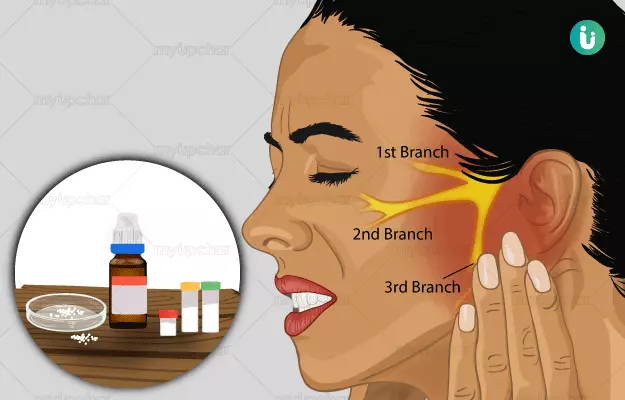The following are some homeopathic remedies for trigeminal neuralgia:
- Aconitum Napellus
Common Name: Monkshood
Symptoms: The characteristic symptoms for the indication of aconite are restlessness, constant fear and anguish and acute sudden onset of fever. This remedy only affects the functions of the body; it does not have any effect on the structure of body tissues. Patients who benefit from this remedy also experience the following symptoms:
- Vertigo that worsens on shaking one's head and on getting up
- Pain at the root of nose (top part of the nose where the nose meets the forehead)
- Numbness and a tingling sensation in cheeks
- Left-sided neuralgia
- Jaw pain
Symptoms aggravate in a warm room, in the evening, at night, on lying on the affected side, and dry cold winds, but feel better in open air.
- Arsenicum Album
Common Name: Arsenious acid, arsenic trioxide
Symptoms: Arsenious acid acts on all the tissues and organs in the body. People who benefit from this remedy tend to be restless and experience worsening of symptoms at night. It helps relieve the following symptoms:
- Headache that is relieved on exposure to cold weather
- Tinnitus during an outburst of pain
- Yellow and swollen face covered with sweat
- Burning, needle-like pain on the face
- Pain in the tongue along with a burning sensation
- Painful teeth
Symptoms worsen after midnight, on consuming cold food and beverages and in wet weather, but get better on having warm drinks and on elevating one's head.
- Belladonna
Common Name: Deadly nightshade
Symptoms: Deadly nightshade works well on the nervous system, especially the parts that cause pain, twitching, and convulsions. It also has significant action on the cardiovascular system. Belladonna is used to treat dry mouth, skin flushing, especially that of the face and neuralgic pains that come and go suddenly. These patients also experience symptoms like:
- Vertigo with a tendency to fall backwards or to the left side
- Headache, mainly in the forehead and on the right side. It usually worsens on lying down
- Pain that aggravates on touching the affected area, and on lying down and gets better on applying pressure
- Throbbing pain in eyes and teeth along with swelling and pain in the tongue
- Bluish discolouration of face along with swelling, and a sensation of heat and convulsive motion of muscles
These symptoms aggravate in the afternoon, touching the affected ara and lying down, but improve when the patient sits in a semi-erect position.
- Colchicum Autumnale
Common Name: Meadow saffron (colchicum)
Symptoms: Meadow saffron affects mainly the periosteum (outer layer of the bones) and muscles. It is useful in the management of tearing pain, especially those that aggravate on touch, and after the evening. It also helps relieve the following symptoms:
- Headache, specifically in the forehead and sides of the head that aggravates in the afternoon and evening
- Contracted left pupil with tearing pain in eyes
- Sharp, shooting pain on the outer ear, particularly below the tragus of the right ear
- Shifting pain in the facial muscles
- Inflammed cheeks
- Jaw angle pain, especially on the right side
- Dry mouth
- Toothache
These symptoms worsen on moving the affected area, mental exertion, and from sundown to sunrise, but improve on bending forward.
- Gelsemium Sempervirens
Common Name: Yellow jasmine (gelsemium)
Symptoms: Yellow jasmine mainly acts on the nervous system and is indicated in paralysis of motor nerves that control voluntary movement. Patients who benefit from this remedy show the following symptoms:
- Head feels heavy
- Dull, heavy headache around the eyelids
- Temple pain (pain in the sides of the head) that extends up to the ears
- Pain in the nerve supplying around eyes along with contraction and twitching
- Flushed face
- Facial neuralgia
- Contractions in facial muscles with chin trembling
- Pain radiating from throat to ear
Symptoms worsen when thinking of the condition and in humid weather. The patient feels better in open air and on bending forward.
- Kalium Iodatum
Common Name: Iodide of potassium (kali hydriodicum)
Symptoms: Iodide of potassium acts mainly on the connective tissues and helps reduce oedema. Those who benefit from this remedy exhibit the following symptoms:
- Intense headache
- Severe pain in eyes and root of the nose
- Pain in facial nerves
- Piercing or stabbing pain in the upper jaw
- Piercing or deep pain in ears
Symptoms worsen at night, with warm clothing, and in damp weather, but improve on moving about in open air.
- Magnesium Phosphoricum
Common Name: Phosphate of magnesia (magnesia phosphorica)
Symptoms: Magnesium phosphoricum is the best remedy for relieving muscle spasms and cramps, and neuralgic pain, especially those that are relieved by warmth. It also helps manage the following symptoms:
- Vertigo
- Pain above the eyes with eyelid twitching
- Nerve pain in ears that worsens when the patient washes their face with cold water
- Pain in teeth which improves on having hot drinks
- Angina pectoris (chest pain due to reduced blood supply to the heart)
Symptoms worsen at night, on touching the affected area, and in cold weather, while they improve on putting pressure on the area and with warmth.
- Mezereum
Common Name: Spurge olive
Symptoms: Neuralgia of teeth and face, as well as skin and bone conditions, are the important indications for this remedy. Spurge olive helps manage the following symptoms:
- Different type of pain along
- Extreme sensitivity to cold air
- Aggressive neuralgia of face and teeth extending to the ear that worsens on eating and improves near a hot stove
- Cluster headaches after an eye operation
- Stiffness in bones around eyes along with pain that radiates downwards
Symptoms aggravate after evening and till midnight, on touching the affected area, in cold air and after consuming warm food, but get better in open air.
- Phosphorus
Common Name: Phosphorus
Symptoms: Phosphorus is used in conditions that lead to inflammation of the spinal cord and nerves and cause destruction of bones (mainly the lower jaw bone), and paralysis. It helps relieve the following symptoms:
- Vertigo on rising in elderly people
- Neuralgia and burning pain; affected parts must be kept warm
- Pain in bones that surround eyes
- Tearing pain in facial bones
- Redness in cheeks
- Pain in teeth after doing laundry
Symptoms worsen in the evening, on touching the affected area, and on consumption of warm food or drink. They improve in open air, in the dark, on sleeping and on lying on the right side.
- Hecla Lava
Common Name: Lava scoriae from Mt. Hecla (Hekla lava)
Symptoms: Hecla lava acts strongly on jaws and is very effective in the management of gum abscess and bone inflammation. Those who benefit from this remedy also experience the following symptoms:
- Nerve pain in the face after tooth extraction and due to caries
- Toothache
- Swelling in jaws
- Enlarged cheekbone (maxillary bone)
- Verbascum Thapsus
Common Name: Mullein (verbascum)
Symptoms: Mullein is the remedy of choice in trigeminal neuralgia due to its profound action on the trigeminal nerve and ears. It also acts on the respiratory tract and bladder and helps relieve the following symptoms:
- Neuralgia on the left side of the face, temporomandibular (jaw) joint and ear, with a sensation as if the parts are being crushed with tongs
- Pain that occurs at the same time in the morning and afternoon every day
- Pain in ears with a feeling as if something is stuck in the ear
These symptoms worsen on sneezing, biting hard and with change in temperature.
- Rhus Toxicodendron
Common Name: Poison-ivy
Symptoms: Poison-ivy is mainly indicated in rheumatism and tearing type of pain. Patients who benefit from this remedy exhibit the following symptoms:
- A sensation of heaviness in the head with vertigo on getting up
- Pain in the back of the head that worsens on touch
- Cracking of jaws on eating
- Sensitivity of cheeks to touch
- Nerve pain and chills in the face that worsens in the evening
Symptoms worsen at night, on resting on one's back or right side, and in cold and rainy weather. The patient feels better on rubbing the affected area or using warm applications. Warm and dry weather also improves the symptoms.



























